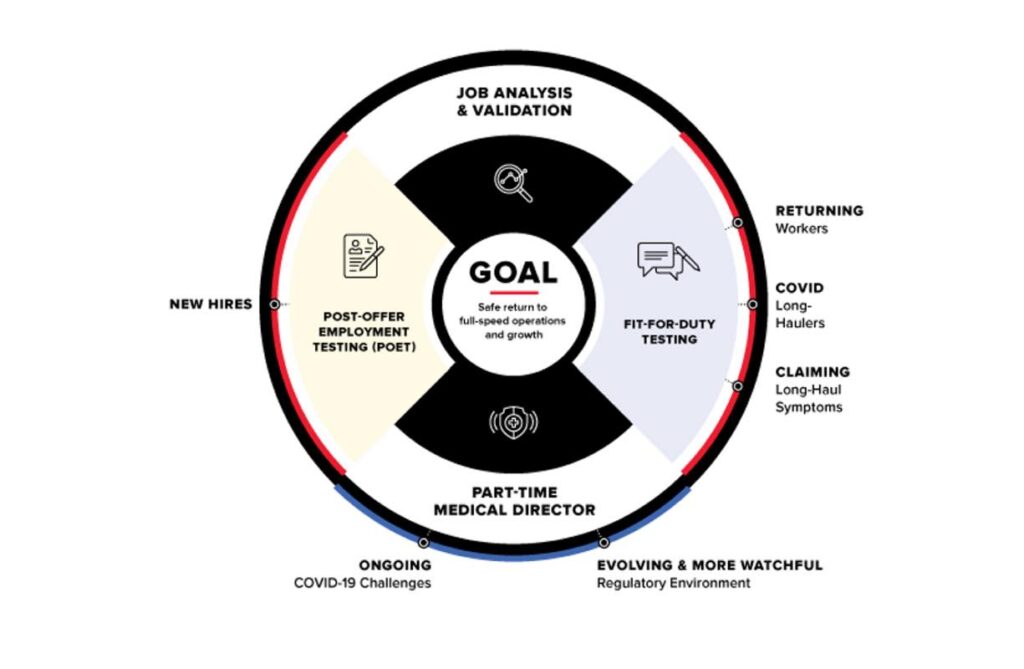A Message on COVID-19 from WorkSTEPS Chief Medical Officer, Dr. Ben Hoffman:
Don’t Count on Perfect, Work on Making Everything Good
From recent, personal experience, I can tell you that current testing technologies on the market are far from perfect. The challenges are many, and include variability in getting material to test (e.g., swab technique), problems with blood-to-reagent proportions, the time it takes to get a sample to the lab, and fundamental limits to test accuracy…especially in the early stages of disease when people are already shedding the virus. Testing is imperfect, and it will remain imperfect for some time to come.
And yet, testing is a key component of corporate RTW planning, as well as roadmaps to get our communities, states and nation moving again.
How worried should we be that testing remains flawed? If all we we’re doing is testing, I’d say that we have a huge problem. But testing is not all we’re doing.
And here I ask you to think about the mitigation measures your company is taking as a series of filters in a system built to remove the risk of critical illness, and to reduce further business interruptions.
- Testing: Your company should put testing protocols in place to identify people who may be sick as well as those who are likely immune. Antibody testing is also useful in determining if close contacts of those who have tested positive due to being ill need to have a prolonged quarantine. But tests are imperfect, so…
- Self-Quarantine: Employees should understand tell-tale symptoms of illness and incentives should be aligned to make it easy for them to make the choice to remain at home. But employees may be asymptomatic or may ignore advice to stay home, so…
- Screening: Employees who show up to work should answer screening questions and have their temperature checked. But, sick-but-asymptomatic employees will still get through, so…
- Basic Preventive Measures: Employees should remain six feet apart. Surfaces should be disinfected frequently. People should wash their hands and not touch their face. Masks should be worn to prevent the spread of droplets (see video here).
None of the above layers of the filtering system are perfect, but if we work to make them all good, we end up with effective protection from the spread of Covid-19 and reduce to nearly-zero the chance of business-disrupting outbreaks.
While we wait for testing science to get better, there is much we can do to operationalize “good” at every layer of the system every day.
Before I wrap this up, some shout-outs to three people without whom I could not provide this bi-weekly brief. My friend and colleague Chuck Reynolds of Reynolds Insights has partnered with me for almost 20 years to help create health-related communications. His ability to focus in on critical issues and to clearly communicate complicated ideas is unmatched and incredibly valuable at this time of crisis.
Dr. Tony Nigliazzo and Loraine Kanyare, ARNP, MPH have worked nonstop to help monitor, sift and make sense of medical and business-relevant information since the pandemic began. Dr. Nigliazzo is a recent addition to the WorkSTEPS team and has taken the responsibility for reviewing and distilling an immense amount of scientific literature. Fortunately, Tony is a bit of a book worm, so he is a good fit for this demanding work. Loraine works with Tony, helping to make sure the information we present in our Briefs is relevant and as actionable as possible. She brings experience, intellect, practicality and a global perspective to the team.
I’m proud to work with such an all-star team, and I’m grateful they put up with my sometimes pie-in-the-sky musings. It’s much appreciated.
As much as I hope you’re finding our Covid-19 briefs useful now, I hope this newsletter continues beyond the crisis. It’s almost hard to recall, but there is a lot more to keeping a workforce safe and productive than protecting them from Covid-19!
Be well and stay safe.
Ben Hoffman, MD, MPH
Chief Medical Officer, WorkSTEPS
Click here for more info on our Coronavirus Medical Hotline for Employers & Employees
Medical:
Doubling time (deaths) 9 days
Coronavirus is spreading from the nation’s biggest cities into the suburbs and rural regions. On Saturday, COVID-19 cases in the United States passed 700,000. The virus is the leading cause of mortality in the U.S right now. How the pandemic will end depends in part on how individual Americans behave in the interim, and on a vaccine and ongoing medical trials for treatment. If we underestimate the virus, it may be at our own peril.

An average of 146,000 people per day have been tested for the virus nationally so far this month, according to the COVID Tracking Project. A total of 3.6 million tests have been administered. But to reopen the US by mid-May, the number of daily tests performed should be 500,000 to 700,000, according to researchers at Harvard University.
Governors facing growing pressure to revive economies decimated by the coronavirus said on Sunday that a shortage of tests was among the most significant hurdles in the way of lifting restrictions in their states.
Aerosols and droplets generated during speech have been implicated in the person-to-person transmission of viruses, and there is current interest in understanding the mechanisms responsible for the spread of Covid-19 by these means. We found that when the person said, “stay healthy,” numerous droplets ranging from 20 to 500 μm were generated. This New England Journal of Medicine study further reinforces the utility of wearing face masks.
A Chicago hospital clinical trial of Covid-19 Gilead Sciences’ medication Remdesivir reported rapid recoveries in fever and respiratory symptoms, with nearly all patients discharged in less than a week. The entire world has been waiting for results from Gilead’s clinical trials which, if safe and effective, could become the first approved treatment against the virus. Similar trials are being run concurrently at other institutions and more data will be needed for certainty.
Mitigation / Suppression:
The WHO revised its recommendations in “Considerations in adjusting public health and social measures in the context of “COVID-19 Interim guidance 16 April 2020” stressing the need to minimize a resurgence of COVID-19 following removal of public restrictions.
Implementation of the adjusting of public health and social measures (PHSM)
The adjusting of PHSM, including large-scale movement restrictions, needs to minimize the risk of a resurgence in COVID-19 cases:
COVID-19 transmission is controlled to a level of sporadic cases and clusters of cases, all from known contacts or importations; at a minimum, new cases would be reduced to a level that the health system can manage based on health care capacity.
Transmission can be controlled through two complementary approaches: (i) breaking chains of transmission by detecting, testing, isolating, and treating cases and quarantining contacts and (ii) monitoring hot spots of disease circulation through respiratory disease or influenza-like illness surveillance, coupled with serological surveys.
President Trump told the nation’s governors on Thursday that they could begin reopening businesses, restaurants and other elements of daily life by May 1 or earlier if they wanted, abandoning the threat of Federal Government intervention.
Demonstrators across the country violated social-distancing orders to call for the reopening of states and the American economy. The rallies, like the one outside the state Capitol in Austin, Texas, above, rode a wave of similar protests this past week. On Saturday alone, people also gathered in Indianapolis, IN.; Carson City, NV.; Annapolis, MD.; Salt Lake City, UT, and Brookfield, WI.
A recent study on coronavirus testing by Boston Health Care for the Homeless Program (BHCHP) and local partners further confirmed asymptomatic spread of the coronavirus. BHCHP had discovered a small cluster of positive test results among people staying at Pine Street Inn and moved to perform universal testing of everyone entering the shelter. Of 397 people who were tested, 146 (36%) tested positive. The vast majority of newly identified cases had no symptoms and no fever on a single point-in-time assessment. This study shows the urgent need for widespread testing to identify clusters of disease and contact tracing.
Corporate:
History as our guide:
The second wave of the flu was attributed to movement of US troops spreading the virus primarily by train; i.e. travel of people. The availability and prevalence of the modes of transportation for the general population today impart the same risk of a viral resurgence following relaxation of mitigation strategies.

On Thursday, seven Midwestern governors announced a coalition to open the Midwest economic region. In a letter from Michigan Governor Gretchen Whitmer’s office, she and the governors of Ohio, Wisconsin, Minnesota, Illinois, Indiana, and Kentucky announced the partnership. The goal of the close coordination is to ensure their leadership reopens carefully, weighing the economy and people’s lives. New York Governor Cuomo announced the state and neighboring East Coast states continue to pause reopening of businesses through at least May 15. Cuomo said he is working with the governors of seven Northeastern states- New Jersey, Pennsylvania, Rhode Island, Connecticut, Massachusetts, and Delaware to create a plan for reopening their state’s economies. The West coast has formed a similar coalition. This is where all 50 states stand on reopening.
The Work From Home WorkSTEPS Medical Team:

Ben Hoffman, MD, MPH
Chief Medical Officer

Tony Nigliazzo, MD
Medical Director

Loraine Kanyare, MSN, MPH, RN
Director of Case Management

Robert L. Levitin, MD
Physician Consultant

Lynda Phillips, LVN
Nurse Case Manager

Codey Church, LVN
Nurse Case Manager

Kerry Womack, LVN
Nurse Case Manager

Chuck Reynolds
Strategic Communications Consultant




